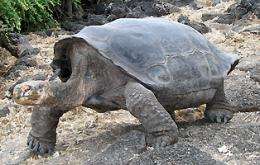Genetic Analysis Gives Hope That Extinct Tortoise Species May Live Again

(PhysOrg.com) -- Thanks to genetic data gleaned from the bones found in a several museum collections, an international team of researchers led by scientists from Yale believes it may be possible to resurrect a tortoise species hunted to extinction by whalers visiting the Galapagos Islands during the early 19th century, before Charles Darwin made his famous visit.
A genetic analysis of 156 tortoises living in captivity and the DNA taken from remains of specimens of the now-extinct Chelonoidis elephantopus revealed that nine are descendents of the vanished species, which once made its home on Floreana Island in the Galapagos. Over a few generations, a selective breeding program among these tortoises should be able to revive the C. elephantopus species, said Adalgisa Caccone, senior research scientist in the department of ecology and evolutionary biology at Yale and senior author of the piece published this week in the online journal PLoS ONE.
“Theoretically, we can rescue a species that has gone extinct,’’ Caccone said. “Our lab calls it the Lazurus project.”
In 2007, Caccone and others discovered genetic relatives to “Lonesome George” the last known survivor of another species of Galapagos tortoise and an icon of the conservation movement. The team believes that the similar genetic hybrids living in captivity on the Galapagos were descendents of tortoises that were taken by whalers as future meals but then thrown overboard to make room for the more lucrative cargo of whale blubber. These tortoises then swam to nearby islands and mated with natives there. Floreana’s flat topography made it a popular spot for whalers to stop and snatch tortoises for meals, leading to the extinction of C. elephantopus.
The comparison of genetic data from remains in museums to data banks with DNA sequences of living tortoises made it possible to identify relatives of extinct animals, Caccone said. However, it will take at least four generations of selective breeding - about 100 years - to bring a genetically identical member of C. elephantopus “back to life.”
“We won’t be around to see it, but it can be done,” she said.
Other Yale authors of the paper are Edgar Benavides and Jeffrey R. Powell. Researchers from the University of British Columbia Okanagan, University of Crete, State University New York Syracuse and the Galapagos National Park Service contributed to the research.
Provided by Yale University



















